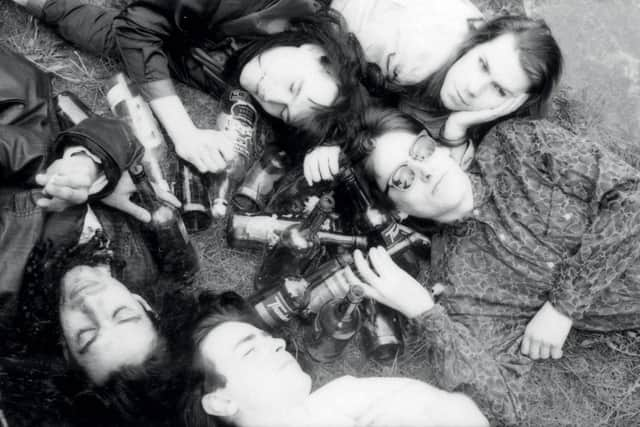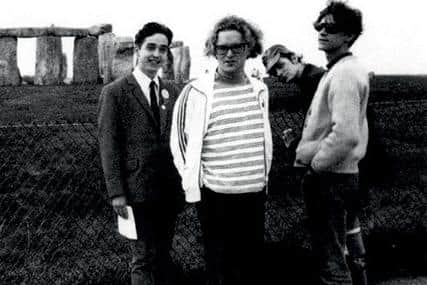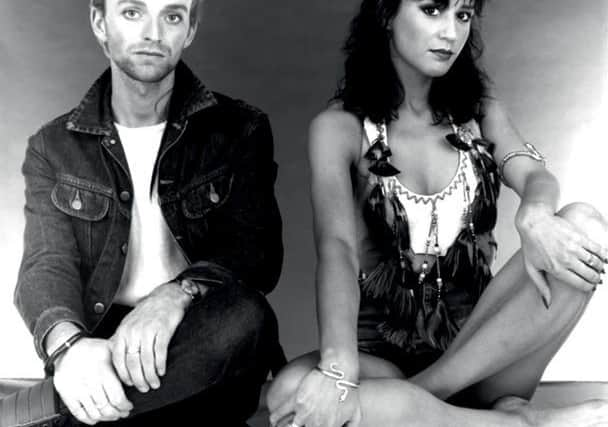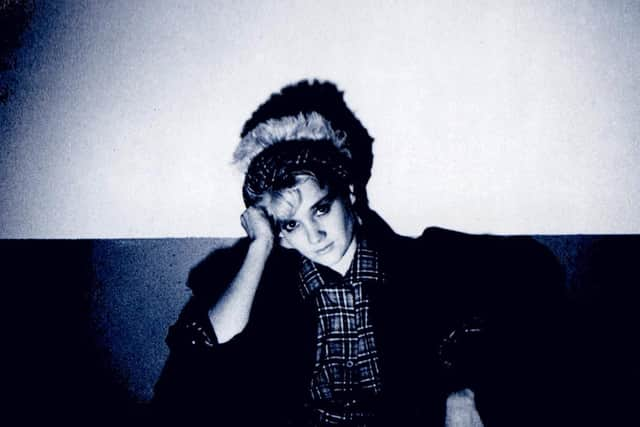Where Were You? box set celebrates a defining period for Leeds music scene
Gathering tracks from 68 artists, the Cherry Red compilation commemorates a particularly vibrant period for the city’s music scene, from which sprang the likes of Soft Cell, Gang of Four, The Mekons, Scritti Politti, the Sisters of Mercy, The Mission and The Wedding Present, who would go on to international renown. But also memorialised are dozens of lesser-known acts, such as Rouge, Rats and Delicious and Shake Appeal, who may only have released one or two singles yet are worthy of note.
The collection is the brainchild of Benoit Farvak, the French-born guitarist with Leeds band Salvation who were part of the city’s Gothic scene in the 1980s and still continue to perform today. He assembled the tracklist with Richard Rouska, musician, writer and founder of indie label Rouska Records.
Advertisement
Hide AdAdvertisement
Hide Ad“It covers the early punk years, post-punk, then it goes into the darker Goth scene and all the way down to the indie years and shoegazers and then electronic stuff coming in towards the end,” says Farvak, noting how “coherent” it all sounds. “Especially at that time, you’d think all those bands had nothing in common – in fact there was a bit of competition, you would not mix with the other bands etcetera – but looking at it now, and listening to it, it really makes sense.


“The idea was to do it in chronological order. At one stage, we thought should we do a more indie CD and Goth on another CD, but if you listen to them in chronological order it really holds together.”
Farvak says it’s a “mystery” why nobody has ever done such a compilation before. “Every city has had a compilation – or several compilations – but not Leeds, (at least) not such a complete retrospective. I have a relationship with Cherry Red Records because they brought out a compilation of Salvation (songs) a long time ago, so I kept in touch with them. I came up with the idea a long time ago and it was never (the) right (time), but I kept at it. I was very persistent and eventually they said, ‘It’s not a bad idea, we’ll do it’ and I was over the moon.”
He and Rouska put together tracklist with the label, but licensing some of the material was sometimes tricky. “Cherry Red already owned some of the tracks, that was easy, and the major labels – Universal and Warners – have a good connection with them, but then the hard work was tracing the very small bands from way back, that took a long time,” Farvak says. “Contacting certain people to get phone numbers, but eventually we got hold of everybody who we wanted on it. It took a long time, a lot of work but it happened in the end.”
Advertisement
Hide AdAdvertisement
Hide AdFarvak remembers the city’s music scene being quite tribal in the ’80s. “It’s been well documented that everyone had their own territory in The Faversham in particular,” he says. “You knew the Goths would congregate in the corner, you would not so much communicate (with others). So there was competition, but look now, you may have thought at the time that bands had nothing in common, but listening to the whole compilation it’s very coherent. It’s basically young musicians playing guitar-orientated alternative music – Age of Chance, The Wedding Present, Sisters – it’s not much difference in hindsight, that’s my perception anyway. It really holds together, it’s diverse yet very coherent.”


The inspiration for many of bands on the compilation, including Gang of Four, The Mekons, Scritti Politti, Delta 5, and Soft Cell, was the Sex Pistols’ gig at Leeds Polytechnic in December 1976. “That was the first big catalyst, from what I’ve read, and all these kids went on to form punk and post-punk bands – and then enters John Keenan. It was very DIY, bands would rehearse in the cellars, there was no big business behind it. They didn’t have any money, it was not contrived and promoter John Keenan gave them a chance.”
Ben settled in Leeds after studying at the University of Leeds. “I got the chance to be a teaching assistant and never went back to France,” he says. He joined Salvation in 1987, recalling that the Goth scene at the time was “very DIY, it wasn’t corporate at all, you made your own clothes and records on small four-track machines – nothing like now”. “It was very underground. If you looked odd, if you were a ‘weirdo’ you’d have to be reasonably careful in town, you could get beaten up.” Hence Goths “were restricted” to the Faversham, the Fenton, Le Phono and the Warehouse. “You’d have to think twice before entering a pub if you looked alternative.”
These days he works as an interpreter and translator, but still plays bass with Salvation. In October they will be playing a Singles and EPs 83-86 set with The March Violets at Tomorrow’s Ghosts festival in Whitby.
Advertisement
Hide AdAdvertisement
Hide AdAmong the artists featured on Where Were You? are Vicious Pink, friends of Soft Cell who later went on to release an album in their own right in the 80s. Keyboard player Brian Moss says: “We are pleased to be involved and the finished article looks and sounds great. Leeds-based artists never got the recognition they deserved, like other northern cities such as Manchester, Liverpool, Sheffield etc rightly did, so it’s about time!”


Singer Josie Warden adds: “It’s been a long time coming. It’s an absolute privilege to be a part of this very talented group of artists.”
Anni Hogan, who was a member of Marc and the Mambs before embarking on a solo career, says she has “great memories of a burgeoning music scene in a city ripe with creativity (and strife, politically and tragically the Yorkshire Ripper struck in 1979, my inaugural year in Leeds)”.
“It was a crazy, inspiring time,” he adds. “The first time I saw Marc Almond, he was playing music I did not know djing at Leeds Warehouse, he was playing a fantastic set djing, I was hooked by the music and Leeds Warehouse which was a scene unto itself.
Advertisement
Hide AdAdvertisement
Hide Ad“I saw Soft Cell at Futurama 2 in Leeds and my mind was blown with the sensational intensity of Marc and Dave’s performance. It was thrilling for me and I got their Mutant Moments EP. Music for Pleasure played on the Friday too and I put them on at Leeds Amnesia 1981 when I DJ-ed and promoted there.


“I booked Depeche Mode (on their first tour), A Certain Ratio and of course Soft Cell, the gig was filmed at the time and now memorialised on DVD. Vicious Pink Phenomena danced with them at Amnesia, I became friends with Marc and Dave and Josie and Brian via the Leeds music scene and particularly hanging in Leeds Warehouse.
“Leeds Faversham too was another hotspot in the Leeds music scene. A favourite watering hole and pool table for Leeds bands, DJs and, of course, students, of which I was one to begin with. I often saw Claire Shearsby and Sisters’ Andrew Eldritch playing pool whilst still maintaining cool. Soft Cell hung there too. The Fav jukebox was phenomenal, including local bands’ 45s along with all the fantastic punk, electronic, glam and 60s raves.
“I arrived at Leeds University as a fresher in the October, spent all my grant (remember those?) on records, firstly at the Uni record shop then ritualistically spending hours in Jumbo Records, situated in the Merrion Centre, chatting to super cool owners Lornette and Hunter Smith and Mike, who gave me tons of fantastic promos for my DJ life in Leeds venues from late 1980-1983 at Leeds Amnesia, Leeds Warehouse, Le Phonographique and the Staging Post in Seacroft.
Advertisement
Hide AdAdvertisement
Hide Ad“Once I hit Leeds, music and the fashion connected took all my interest, record shops, gigs, clubs, djing and then Marc and The Mambas.
“In 1982 I lived with Marc Almond in Headingley and he asked me to join his Marc and the Mambas project full time and we were to record an LP. The initial Marc and the Mambas’ release was ’82 Sleaze / Fun City , so things professionally and artistically seeded and developed for me in Leeds before I eventually moved down to London as we all did back then.
“In 1983 I moved down partially, still returning at the weekend to dDJ at Le Phonographique, but I was also now guest djing at the Batcave and I moved into Lydia Lunch’s place in West London whilst she was in USA, it was handy for Alvic studios in West Kensington and I began recording my EP Annie Hogan Plays Kickabye in October 1983 hanging out with and collaborating with Marc, Nick Cave, Anita Lane, Budgie, (Siouxsie also there hanging out), Gini Ball, Foetus and my co-writer Jessamy Calkin, now features editor at the Telegraph but back then tour manager for Einstürzende Neubauten amongst her roles.
“I wrote and recorded The Executioner’s Song (Kickabye) during this very artistic and prolific period in 1983, singing Jessamy’s lyric. Cherry Red requested this particular track, I think it represents a period of extreme creativity and productivity from me and those around me and the EP links me with one headphone still in Leeds and one in London so a very transformative time.”
Advertisement
Hide AdAdvertisement
Hide AdCarl Puttnam is also pleased to see his band Cud included. “It feels like we’re official,” he says.
The song Blondes, which is included in the compilation, was the B-side of the band’s third single. “It’s become a mainstay of our live shows,” Puttnam says. “Blondes had a kind of Sixties groove and a long play out; we used to all take turns ending our playing, first Mike, then Will, and last, Steve drumming while I did a dance duel with him. We’d both work the other into a flailing mess and leave the stage completely exhausted. It was pretty cool.”
He adds: “Early on, I had a bit of an honesty mission and so every song had to be about a real person or happening in my life and this was one of them. The person who this song was about would have easily identified themselves from the lyrics, and after its recording, realising this, I made a heartfelt apology to them. Strangely, they said they were quite flattered by the mention in tune, but I’ve changed a few of the words since then in an attempt to disguise the person.
“The song made me feel a little like a bully, so I started coding my lyrics to conceal their true meaning, but hopefully adding a exoticism or mystery to them, which I thought made them more open to interpretation and so universal and personal at the same time.
Advertisement
Hide AdAdvertisement
Hide Ad“Back then, I was very serious about how lyrics were perceived and the meaning that was conveyed. It’s funny though, with new material, I don’t feel any need to either be truthful or to hide identities. It’s a ‘how am I feeling at this moment?’ thing, and I’m wanting to please only myself or the person who I’m flattering or slandering in a song.
He believes the Leeds music scene has “really changed since the 1980s and early 90s”.
“From our perspective it seemed more cliquey back then, we would feel snubbed by sections of ‘the Scene’ while accepted by other parties. The impression I get of the last 15-20 years is that everyone is for everyone and that’s got to be better.
“One journalist from Leeds would always describe us saying ‘they’re not from Leeds’, which would sound a little silly these days. He obviously knew that other bands were ex-students and the like and ‘not from Leeds’, and we didn’t ever pretend to be anything other, so that kind of galled.
Advertisement
Hide AdAdvertisement
Hide Ad“The scene was a lot less professional and DIY in attitude, which makes my memory of those days seem more romantic than the more savvy scene of today. We printed our own posters and had to avoid the pirates, who claimed poster sites, from knocking you off your ladder. We made our own T-shirts that lasted two washes, before the design moved towards your armpit as the fabric shrunk. Our record company was in the first floor bedsit of one of the Weddoes. Our publisher a basement flat in Hyde Park.
“At the time of Blondes, we were practising in the basement of a terraced house in LS2. The floor was covered in old pallets so we weren’t stood in puddles while playing electric guitars; the local youth eyeballing us through a coal hole turned window. We'd share a single three ways. Ten pence from the corner shop. It was a nutty time.”
Cud bassist Will Potter adds: “Pretty much any band I can recall from the era is featured on Where Were You?, many that inspired Cud, that we’ve supported, befriended or given an amicable nod to at The Fenton or Fav. We knew Leeds had a thriving music scene when we converged on the city in the late 80s and in Cud’s earliest incarnation, we covered The Mekons’ Where Were You?.
“The compilation stirs fond memories of catching Age of Chance and the Wedding Present sharing a bill upstairs at the Royal Park, spontaneous Ritzen Ratzen Rotzer shows in the Leeds Poly Fine Art studios, appreciating the cred of having one of the Three Johns as a tutor, regular nights at the Duchess, support-slot and guest-list blagging. It’s a fantasy Futurama Festival roster.
Advertisement
Hide AdAdvertisement
Hide Ad“Leeds has been labelled Goth City or overshadowed by neighbours to the west; this collection should go a long way to reminding people with ears that our spiritual home was and is a hotbed of creativity.”
Where Were You? is out now.
